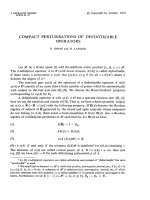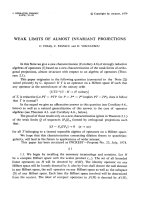Báo cáo toán học: "Integral Closures of Monomial Ideals and Fulkersonian Hypergraphs" ppsx
Bạn đang xem bản rút gọn của tài liệu. Xem và tải ngay bản đầy đủ của tài liệu tại đây (105.97 KB, 6 trang )
Vietnam Journal of Mathematics 34:4 (2006) 489–494
Integral Closures of Monomial Ideals
and Fulkersonian Hypergraphs
Ngo Viet Tr ung
Institute of Mathematics, 1 8 Hoang Quoc Viet Road, 10307 Hanoi, Vietnam
Dedicated to Professor Do Long Van on the occasion of his 65
th
birthday
Received June 22, 2005
Abstract. We prove that the integral closures of the pow ers of a squarefree monomial
ideal
I equal the symbolic powers if and o nly if I is the edge ideal of a Fulkersonian
hypergraph.
2000 Mathematics Subject Classification: 13B22, 05C65.
Keywork: Monom ial ideal, Fulkersonian h ypergraph.
1. Introduction
Let V be a finite set. A hypergraph Δ on V is a family of subsets of V .The
elements of V and Δ are called the vertices and the edges of Δ, respectively. We
call Δ a simple hypergraph if there are no inclusions between the edges of Δ.
Assume that V = {1, , n} and let R = K[x
1
, , x
n
] be a polynomial ring
over a field K. The edge ideal I(Δ) of Δ in R is the ideal generated by all
monomials of the form
i∈F
x
i
with F ∈ Δ. Bythiswayweobtainanone-to-
one correspondence between simple hypergraphs and squarefree monomials.
It is showed [6] (and implicitly in [4]) that the symbolic powers of I(Δ) coin-
cide with the ordinary powers of I(Δ) if and only if Δ is a Mengerian hypergraph,
which is defined by a min-max equation in Integer Linear Programming. A nat-
ural generalization of the Mengerian hypergraph is the Fulkersonian hypergraph
which is defined by the integrality of the blocking polyhedron. Mengerian and
Fulkersonian hypergraphs belong to a variety of hypergraphs which generalize
bipartite graphs and trees in Graph Theory [1, 2]. They frequently arise in the
polyhedral approach of combinatorial optimization problems.
490 Ngo Viet Trung
The aim of this note is to show that the symbolic powers of I(Δ) coincide
with the integral closure of the ordinary powers of I(Δ) if and only if Δ is a
Fulkersonian hypergraph. We will follow the approach of [5, 6] which describes
the symbolic powers of squarefree monomials by means of the vertex covers of
hypergraphs. This approach will be presented in Sec. 1. The above character-
ization of the integral closure of the ordinary powers of squarefree monomials
ideals will be proved in Sec. 2.
2. Vertex Covers and S ymbolic Powers
Let Δ be a simple hypergraph on V = {1, , n}. For every edge F ∈ Δwe
denote by P
F
the ideal (x
i
| i ∈ F ) in the polynomial ring R = K[x
1
, , x
n
]. Let
I
∗
(Δ) :=
F ∈Δ
P
F
.
Then I
∗
(Δ) is a squarefree monomial ideal in R. It is clear that every squarefree
monomial ideal can be viewed as an ideal of the form I
∗
(Δ).
A subset C of V is called a vertex cover of Δ if it meets every edge. Let
Δ
∗
denote the hypergraph of the minimal vertex covers of Δ. This hypergraph
is known under the name transversal [1] or blocker [2]. It is well-known that
I
∗
(Δ) = I(Δ
∗
). For this reason we call I
∗
(Δ) the vertex cover ideal of Δ.
Viewing a squarefree monomial ideal I as the vertex cover ideal of a hyper-
graph is suited for the study of the symbolic powers of I.IfI = I
∗
(Δ), then the
k-th symbolic power of I is the ideal
I
(k)
=
F ∈Δ
P
k
F
.
The monomials of I
(k)
can be described by means of Δ as follows [5].
Let c =(c
1
, , c
n
) be an arbitrary integral vector in N
n
.Wemaythinkofc
as a multiset consisting of c
i
copies of i for i =1, , n. Thus, a subset C ⊆ V
corresponds to an (0,1)-vector c with c
i
=1ifi ∈ C and c
i
=0ifi ∈ C,and
C is a vertex cover of Δ if
i∈F
c
i
≥ 1 for all F ∈ Δ. For this reason, we call
c a vertex cover of order k of Δ if
i∈F
c
i
≥ k for all F ∈ Δ. Let x
c
denote
the monomial x
c
1
1
···x
c
n
n
.Itisobviousthatx
c
∈ P
F
if and only if
i∈F
c
i
≥ k.
Therefore, x
c
∈ I
(k)
if and only if c is a vertex cover of order k.Inparticular,
x
c
∈ I if and only if c is a vertex cover of order 1.
Let F
1
, , F
m
be the edges of Δ. We may think of Δ as an n × m matrix
M =(e
ij
)withe
ij
=1ifi ∈ F
j
and e
ij
=0ifi ∈ F
j
. One calls M the incidence
matrix of Δ. Since the columns of M are the integral vectors of F
1
, , F
m
,an
integral vector c ∈ N
n
is a vertex cover of order k of Δ if and only if M
T
·c ≥ k1,
where 1 denote the vector (1, , 1) of N
m
.
By the above characterization of monomials of symbolic powers we have
I
(k)
= I
k
if every vertex cover c of order k can be decomposed as a sum of k
vertex cover of order 1 of Δ.
Every integral vector c ∈ N
r
is a vertex cover of some order k ≥ 0. The
minimum order of c is the number o(c):=min{
i∈F
c
i
| F ∈ Δ}. Let σ(c)
Integral Closures of Monomial Ideals and Fulkersonian Hypergraphs 491
denote the maximum number k such that c can be decomposed as a sum of k
vertex cover of order 1. Then I
(k)
= I
k
for all k ≥ 1 if and only if o(c)=τ(c)
for every integral vector c ∈ N
r
.
Using the incidence matrix of the hypergraph of minimal vertex covers one
can characterize the numbers o(c)andτ (c) as follows.
Lemma 2.1. [6, Lemma 1.3] Let M be the incidence matrix of the hypergraph
Δ
∗
of the minimal vertex covers of Δ.Then
(i) o(c)=min{a · c| a ∈ N
n
,M
T
· a ≥ 1},
(ii) σ(c)=max{b · 1| b ∈ N
m
,M· b ≤ c}.
Let M now be the incidence matrix of a hypergraph Δ. One calls Δ a
Mengerian hypergraph [1,2] (or having the max-flow min-cut property [4]) if
min{a · c| a ∈ N
n
,M
T
· a ≥ 1} =max{b · 1| b ∈ N
m
,M· b ≤ c}.
Since I(Δ) = I
∗
(Δ
∗
), switching the role of Δ and Δ
∗
in the above observa-
tions we immediately obtain the following criterion for the equality of ordinary
and symbolic powers of a squarefree monomial ideal.
Theorem 2.1. [6, Corollary 1.6] Let I = I(Δ).ThenI
(k)
= I
k
for all k ≥ 1 if
and only i f Δ is a Mengerian hypergraph.
Remark 2.1. In general, Δ
∗
need not to be a Mengerian hypergraph if Δ is a
Mengerian hypergraph (see e.g. [6, Example 2.8]).
It should be noticed that min{a · 1| a ∈ N
n
,M
T
· a ≥ 1} is the minimum
number of vertices of vertex covers and max{b · 1| b ∈ N
m
,M· b ≤ 1} is the
maximum number of disjoint edges of Δ. If these numbers are equal, one says
that Δ has the K¨onig property [1, 2]. This is a typical property of trees and
bipartite graphs.
3. Fulkersonian Hypergraphs
Let Δ be a simple graph of m edges on n vertices. Let M be the incidence
matrix of Δ. By the duality in Linear Programming we have
min{a · c| a ∈ R
n
+
,M
T
· a ≥ 1} =max{b · 1| b ∈ R
m
+
,M· b ≤ c},
where R
+
denote the set of non-negative real numbers. This implies
min{a · c| a ∈ N
n
,M
T
· a ≥ 1}≤max{b · 1| b ∈ N
m
,M· b ≤ c}.
If equality holds above, we obtain
min{a · c| a ∈ R
n
+
,M
T
· a ≥ 1} =min{a · c| a ∈ N
n
,M
T
· a ≥ 1},
max{b · 1| b ∈ R
m
+
,M· b ≤ c} =max{b · 1| b ∈ N
m
,M· b ≤ c}.
492 Ngo Viet Trung
In this case, the two optimization problems on the left-hand sides have integral
optimal solutions.
For the min problem, this condition is closely related to the integrality of
the polyhedron:
Q(Δ) := {a ∈ R
n
+
| M
T
· a ≥ 1}.
This polyhedron is usually called the blocking polyhedron of Δ [2]. Notice that
an integral vector c ∈ N
n
is a vertex cover of order 1 of Δ if and only if c ∈ Q(Δ).
Lemma 3.1. (see e.g. [1, Lemma 1, p. 203]) min{a · c| a ∈ R
n
,M
T
· a ≥ 1} is
an integer for all c ∈ N
n
if and only if Q(Δ) only has integral extremal points.
One calls Δ a Fulkersonian hypergraph [2] (or paranormal [1]) if Q(Δ) only
has integral extremal points. By the above observation and Lemma 3.1, Fulker-
sonian hypergraphs are generalizations of Mengerian hypergraphs.
Unlike the Mengerian property, the Fulkersonian property is preserved by
passing to the hypergraph of minimal vertex covers.
Lemma 3.2. (see e.g. [1, Corollary, p. 210]) Δ is Fulkersonian if and only if Δ
∗
is Fulkersonian.
We shall see that Fulkersonian hypergraphs can be used to study the integral
closures of powers of monomial ideals.
Let I be an arbitrary monomial ideals. Let
I denote the integral closure of
I. It is easy to see that
I is the monomial ideal generated by all monomial f
such that f
p
∈ I
p
for some p ≥ 1. We say that I is an integrally closed ideal if
I = I.
It is well known that powers of ideals generated by variables are integrally
closed. Since the intersection of integrally closed ideals is again an integrally
closed ideal, symbolic powers of squarefree monomial ideals are integrally closed.
From this it follows that
I
k
⊆ I
(k)
for all k ≥ 0ifI is a squarefree monomial
ideal.
Theorem 3.1. Let I = I
∗
(Δ).ThenI
k
= I
(k)
for all k ≥ 1 if and only if Δ is
a Fulkersonian hypergraph.
Proof. Assume that Q(Δ) is integral with integral vertices a
1
, , a
r
.Wehaveto
show that every monomial x
c
∈ I
(k)
belongs to I
k
. As we have seen in Sec. 1, c
is a vertex cover of order k of Δ. This means M
T
·c ≥ k1. Therefore
1
k
c ∈ Q(Δ).
Hence there are rational numbers l
1
, , l
r
≥ 0withl
1
+ ···+ l
r
=1suchthat
1
k
c = l
1
a
1
+ ···+ l
s
a
r
+ b
for some rational vector b ∈ R
n
+
.Letp be the least common multiple of the
denominators of l
1
, , l
r
and the components of b.Then
pc = kpl
1
a
1
+ ···+ kpl
r
a
r
+ kpb
Integral Closures of Monomial Ideals and Fulkersonian Hypergraphs 493
is a sum of kp integral vectors a
1
, , a
r
in Q(Δ) and the integral vector krb ∈ N
n
.
Since x
a
1
, , x
a
r
∈ I,
(x
c
)
p
=(x
a
1
)
kpl
1
···(x
a
r
)
krl
r
x
kpb
∈ I
kp
.
Therefore, x
c
∈ I
k
as required.
Conversely, assume that I
(k)
= I
k
for all k ≥ 1. Let a
1
, , a
r
now be the
integral vectors corresponding to the minimal vertex covers of Δ. Let P (Δ)
denote the set of all vectors of the form l
1
a
1
+ ···+l
r
a
r
+ b with μ
1
, , μ
r
∈ R
+
and b ∈ R
n
+
.ItisobviousthatP (Δ) ⊆ Q(Δ). We will prove that Q(Δ) = P (Δ),
which shows that a
1
, , a
r
are the extremal points of Q(Δ).
It suffices to show that every rational vector a ∈ Q(Δ) belongs to P (Δ).
Let k be the least common multiple of the denominators of the components
of a.ThenM
T
· (ka) ≥ k1. Hence x
ka
∈ I
(k)
= I
k
. Thus, there exists an
integer p ≥ 1 such that x
pka
∈ I
pk
.SinceI is generated by x
a
1
, , x
a
r
,wehave
x
pka
= x
ν
1
a
1
···x
ν
r
a
r
x
d
for some integral vector d ∈ N
n
and integers ν
1
, , ν
r
with ν
1
+ ···+ ν
r
= pk. It follows that
a =
ν
1
pk
c
1
+ ···+
ν
r
pk
c
r
+
1
pk
d.
Therefore, a ∈ P (Δ), as desired.
By Lemma 3.2, Theorem 3.1 can be reformulated as follows.
Theorem 3.2. Let I = I(Δ).Then
I
k
= I
(k)
for all k ≥ 1 if and only if Δ is
a Fulkersonian hypergraph.
It is obvious that I
(k)
= I
k
for all k ≥ 1 if and only if I
(k)
= I
k
and I
k
= I
k
for all k ≥ 1. Let R[It]=
k≥0
I
k
t
k
be the Rees algebra of I.Itisknown
that R[It] is normal if and only if
I
k
= I
k
for all k ≥ 1. Therefore, combining
Theorem 2.1 and Theorem 3.2 we obtain the following result of Gitler, Valencia
and Villarreal [4, Theorem 3.5].
Corollary 3.1. Let I = I(Δ).ThenΔ is a Mengerian hypergraph if and only
if Δ is a Fulkersonian hypergraph and R[It] is normal.
In an earlier paper, Escobar, Villarreal and Yoshino showed that I
(k)
= I
k
for all k ≥ 1 if and only if Δ is a Fulkersonian hypergraph and R[It]isnormal
[3, Proposition 3.4]. Combining this result with Corollary [4] one can recover
Theorem 2.1.
In view of Corollary 3.1 it is of great interest to study the following
Problem 3.1. Let I = I(Δ). Can one describe the normality of the Rees algebra
R[It] in terms of Δ?
This problem has been solved for the graph case by Hibi and Ohsugi [7],
Simis, Vasconcelos and Villarreal [8].
494 Ngo Viet Trung
Acknowledgment. The author has been informed recently that the main resu lt of
this paper was also obtained by Gitler, Reyes, and Villarreal in the preprint “Blowup
algebras of square-free monomial ideals and some links to combinatorial optimization
problems”, arXiv: math.AC/0609609.
References
1. C. Berge, Hypergraphs, Combinatorics of Finite Sets, North-Holland, Amsterdam,
1989.
2. H. Duc h et, Hypergraphs, Handbook of Combinatorics, Vo l. 1, Elsevier, Amsterdam,
1995, 381–432.
3. C.A. Escobar, R. Villarreal, and Y. Yoshino, Torsion freeness and normality of
blowup rings o f monomial ideals, Commutative algebra, Lect. Notes Pure Appl.
Math. 244 (2006) 69–84.
4. I. Gitler, C. E. Valencia, and R. Villarreal, A note on Rees algebras and the MFMC
property, ArXiv, math.AC/0511307.
5. J. Herzog, T. Hibi, and N. V. Trung, Symbolic powers of monomial ideals and
v ertex cov er algebras, ArXiv, math.AC/0512423, Adv. Math. ( to appear).
6. J. Herzog, T. Hibi, N. V. Trung, and X. Zheng, Standard graded vertex cover
algebras, cycles and leaves, ArXiv, math.AC/0606357, Trans. A mer. Math. Soc.
(to appear).
7. T. Hibi and H . Ohsugi, Normal polytopes arising from finite graphs, J. Algebra
207 (1998) 409–426.
8. A. Simis, W. Vasconcelos, and R. Villarreal, The integral closure of subrings
associated to graphs, J. Algebra 199 (1998) 281–289.









